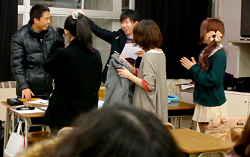Application: Grow’s Staged Self-Directed Learning Model
Grow’s (1996) Staged Self Directed Learning Model provides a framework that adapts situational leadership models from business to help teachers align classroom leadership with the abilities and motivations of the learner, with the objective of facilitating the learner toward self-direction. Scaffolding is a technique educators can use to facilitate self-direction. Scaffolding is a tactic originally suggested by Vygotsky (Schunk, 2004; Watson, 2002), in which the teacher carefully guides the student through the initial stages of learning, then gradually removes support as the student progresses toward independence.
While SDL prepares individual students to be lifelong learners by developing a capacity for self-direction, awareness of metacognitive processes, and a disposition for learning, SDL environments tend to be highly collaborative. A growing trend toward building communities of learning in traditional education and the University of Phoenix collaborative learning model serve as examples of the collaborative nature of SDL.
Criticisms and limitations of self-directed learning
Focusing on how adults take control of their own learning, self-directed learning seems to be neither unique to adults nor universal among adults. A Piagetian may argue that children have the capacity to be lone scientists who will learn best when left alone. Likewise, self-direction may be determined by contextual factors besides adulthood. Brookfield (1995) argues the self-directed learning ideal reflects patriarchal values of individual autonomy and competition while ignoring culture, gender, social networks, time, and the relevance of the individual’s experience. further, a purely self-directed learning environment might provide learning that is relevant to the individual; however, this learning may have limited value outside the individual realm.
Emphasizing this point, Brookfield (1995) argues that self-direction can equate to “separateness and selfishness, with a narcissistic pursuit of private ends in disregard to the consequences of this for others and for wider cultural interests”. Brookfield proposes that adult education should not consider adults as “self-contained… beings” working to engage in “an obsessive focus on the self” but should be used to engage individuals in “cooperative and collective” pursuits that emphasize interactivity and common interests.
For example, an individual may be fully capable of engaging in self-directed study in business management; however, regardless of how much he learns, failing to actively engage with others while learning can severely limit his ability to plan, organize, lead, or control people and processes in a business environment. Likewise, an individual can devour books, tapes, and movies about the Japanese language and culture, but may never be able to speak Japanese or adapt to Japanese culture without integrating social activities into her studies.
In addition to not being a characteristic that is unique to adults, not all adults have the capacity to be self-directed; even adults who do have the capacity to be self-directed may still need support, encouragement, and feedback to engage in and complete credible learning programs. For example, while the University of Phoenix considers adults to be capable of self-direction, a key-value the institution provides is a highly structured and collaborative environment that guides the self-directed learner to master the objectives necessary to demonstrate competency in the learner’s selected area of study (Berg, 2005).




![Your brain can keep growing, adapting, and learning at any age, if you are willing to put in the effort [Image: Copilot]](/images/Images/best-years-for-adult-brain300.png)

